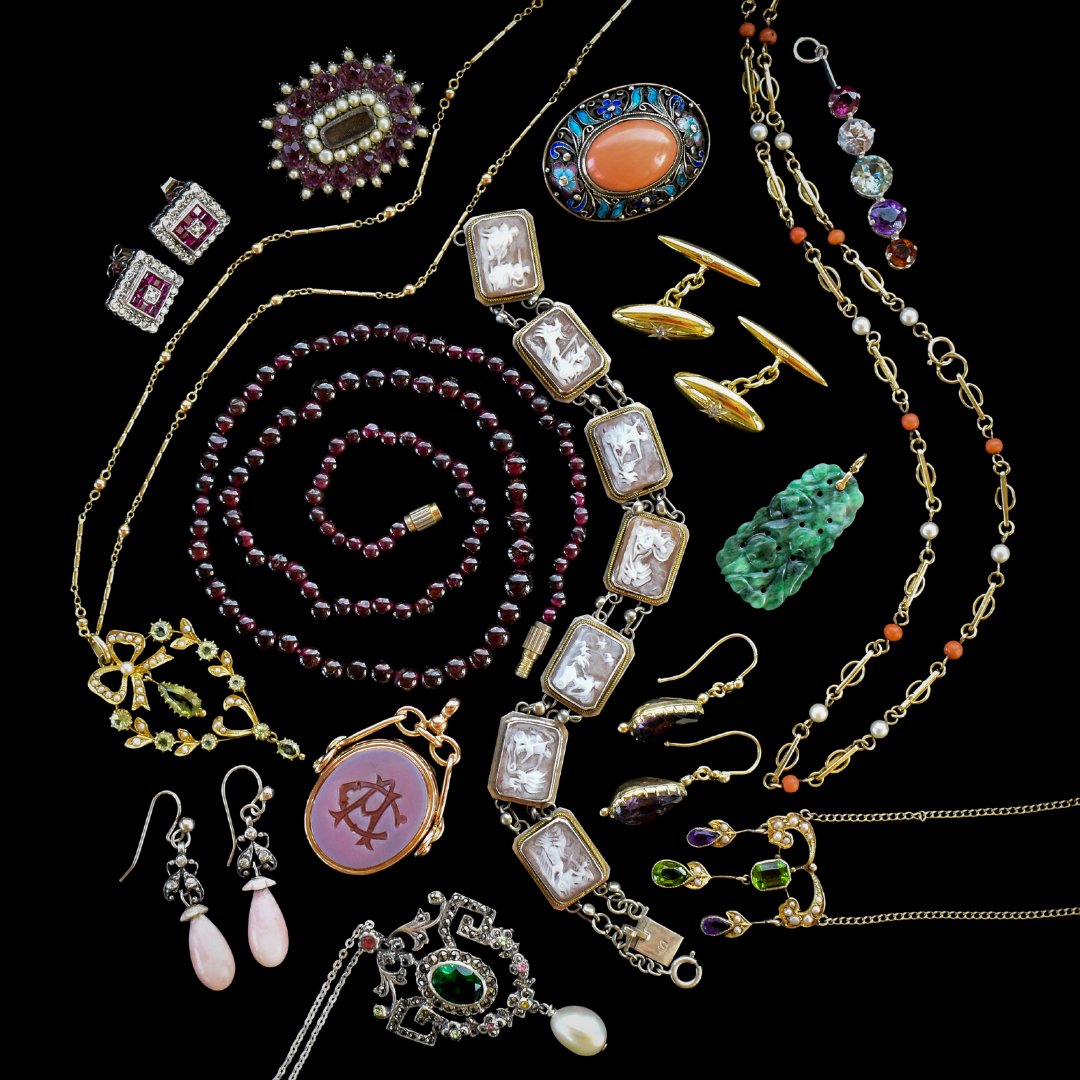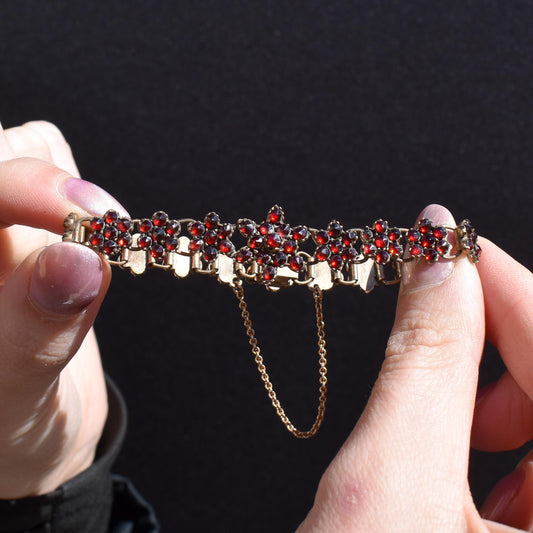-
Antique Pearl and Diamond Cluster 18ct Gold Ring
Prix habituel £1,195.00 GBPPrix habituelPrix unitaire par -
Antique Victorian Bohemian Garnet Star Brooch Pin | Circa. 1890
Prix habituel £295.00 GBPPrix habituelPrix unitaire par -
Antique Victorian Bohemian Garnet Star Silver Brooch Pin | Circa. 1890
Prix habituel £345.00 GBPPrix habituelPrix unitaire par -
Antique Victorian Bohemian Garnet Bracelet | Circa.1890
Prix habituel £545.00 GBPPrix habituelPrix unitaire par -
Antique Victorian 9ct Gold Etruscan Pearl Earrings | Birmingham 1899
Prix habituel £225.00 GBPPrix habituelPrix unitaire par -
Antique Round Garnet Bezel Rivere Necklace | 16"
Prix habituel £685.00 GBPPrix habituelPrix unitaire par -
Antique Victorian Heart Drop 18ct Gold Band Ring | Birmingham 1894
Prix habituel £445.00 GBPPrix habituelPrix unitaire par -
Antique 9ct Yellow Gold Fancy Tassel Charm Pendant - Victorian
Prix habituel £375.00 GBPPrix habituelPrix unitaire par -
Antique Bird & Flowers Shell Cameo Brooch | Victorian
Prix habituel £295.00 GBPPrix habituelPrix unitaire par -
Antique Ruby Starburst Three Stone 15ct Gold Gypsy Ring | Birmingham 1897
Prix habituel £375.00 GBPPrix habituelPrix unitaire par -
Antique Victorian Fancy Link 9ct Yellow Gold Chain Necklace | 54.5" | Murrle Bennett
Prix habituel £925.00 GBPPrix habituelPrix unitaire par -
Antique Victorian '1891' 18ct Gold Plain Stacking Wedding Band Ring
Prix habituel £325.00 GBPPrix habituelPrix unitaire par -
Antique Victorian Fancy Link 9ct Gold Long Chain Necklace | 31.5"
Prix habituel £945.00 GBPPrix habituelPrix unitaire par -
Antique Victorian Old Cut Diamond Buckle Belt 18ct Yellow Gold Ring Band
Prix habituel £685.00 GBPPrix habituelPrix unitaire par -
Antique Victorian Blue Sapphire and Old Cut Diamond Gold Bangle Bracelet
Prix habituel £1,375.00 GBPPrix habituelPrix unitaire par -
Antique Natural Opal 9ct Yellow Gold Bar Brooch Pin
Prix habituel £265.00 GBPPrix habituelPrix unitaire par
Your Victorian Jewellery Questions Answered
How can you tell if jewellery is Victorian?
To determine if jewellery is from the Victorian era, consider these factors:
- Style: Look for designs characteristic of the Victorian era, such as intricate filigree work, nature-inspired motifs (flowers, leaves), and symbolic designs (hearts, snakes).
- Materials: Victorian jewellery often used gold, silver, or rolled gold, and gemstones like diamonds, pearls, amethysts, and garnets.
- Construction: Examine the craftsmanship; Victorian jewellery is known for its fine detail and intricate settings.
- Hallmarks: Check for hallmarks or maker's marks on the jewellery, though not all Victorian jewellery was stamped.
- Clasps and Fastenings: Victorian jewellery may have unique clasps and fastenings specific to the era.
- Historical Documentation: If possible, verify the jewellery's provenance through historical records or family documents.
Was Victorian jewellery stamped?
Not all Victorian jewellery was stamped with hallmarks or maker's marks, as hallmarking regulations varied by region and time. Some pieces may bear these marks, especially if they were made in areas with strict hallmarking laws, like England.
However, the absence of a hallmark doesn't necessarily indicate that the jewellery isn't Victorian. Other factors, such as style, materials, and construction, can help identify Victorian pieces.
Why is Victorian jewellery so valuable?
Victorian jewellery is valuable for several reasons:
- Craftsmanship: Victorian jewellery is known for its intricate craftsmanship, which often involved handwork and attention to detail, making it labour-intensive.
- Materials: Many Victorian pieces used high-quality materials like gold, silver, and precious gemstones, contributing to their value.
- Antique Rarity: Authentic Victorian jewellery is considered antique, and its age and historical significance can increase its worth.
- Collectability: Collectors and enthusiasts often seek Victorian jewellery, which can drive up demand and prices.
- Provenance: Jewellery with a known history or ties to notable individuals.
- Condition: Well-preserved Victorian jewellery in good condition is more valuable.
- Unique Designs: The unique and sentimental designs of Victorian jewellery make them highly sought after by collectors and connoisseurs, further elevating their price.
How can you tell if jewellery is vintage or antique?
To distinguish between vintage and antique jewellery:
- Age: Jewellery is considered vintage if it is at least 20 years old but less than 100 years old. Antique jewellery is typically over 100 years old.
- Style: Research the design and style of the piece. Vintage jewellery may feature design elements from a particular era, while antique jewellery often exhibits characteristics of the era it was made in.
- Materials: Examine the materials used. Older pieces may use materials that were popular during their era, such as Bakelite in vintage pieces or specific metals and gemstones in antique ones.
- Hallmarks: Check for hallmarks or maker's marks, which can indicate the era and origin of the jewellery.
- Construction: Assess the craftsmanship and manufacturing techniques used. Older pieces may display handcrafted details, while newer ones may have more modern manufacturing methods.
- Provenance: Investigate any available historical documentation or provenance that can confirm the age of the jewellery.
By considering these factors, you can determine whether the jewellery in question is vintage or antique.






































